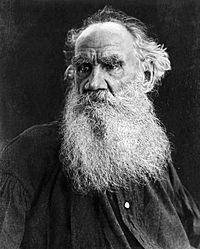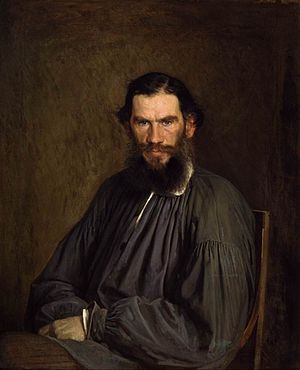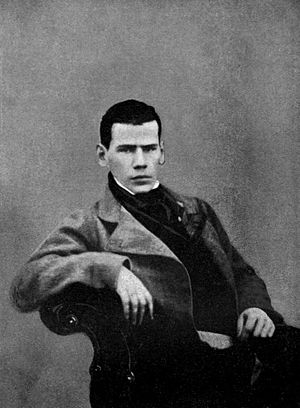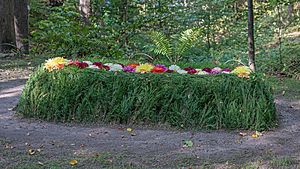Leo Tolstoy facts for kids
Quick facts for kids
Leo Tolstoy
|
|
|---|---|

Tolstoy on 23 May 1908 at Yasnaya Polyana, four months before his 80th birthday.
|
|
| Native name |
Лев Николаевич Толстой
|
| Born | Lev Nikolaevich Tolstoy 9 September 1828 Yasnaya Polyana, Tula Governorate, Russian Empire |
| Died | 20 November 1910 (aged 82) Astapovo, Ryazan Governorate, Russian Empire |
| Resting place | Yasnaya Polyana |
| Occupation | Novelist, short story writer, playwright, essayist |
| Language | Russian |
| Nationality | Russian |
| Period | 1847–1910 |
| Literary movement | Realism |
| Notable works | War and Peace Anna Karenina The Death of Ivan Ilyich The Kingdom of God Is Within You Resurrection |
| Spouse | |
| Children | 14 |
| Signature | |
Count Leo Tolstoy (born September 9, 1828 – died November 20, 1910) was a famous Russian writer. He wrote many important books, like War and Peace and Anna Karenina. Tolstoy believed strongly in peace and not using force. His ideas influenced famous leaders such as Mahatma Gandhi and Martin Luther King.
Contents
Early Life and Education
Leo Tolstoy was born at Yasnaya Polyana. This was his family's large estate in Russia. It was about 12 km (7.5 miles) southwest of Tula. He was the fourth of five children.
His mother died when he was only two years old. His father passed away when Leo was nine. Relatives then raised Tolstoy and his brothers and sisters.
In 1844, Tolstoy started studying at Kazan University. He tried to learn law and oriental languages. However, his teachers said he was "unable and unwilling to learn." Tolstoy left the university before finishing his studies.
He returned to Yasnaya Polyana. Then he spent a lot of time in Moscow, Tula, and Saint Petersburg. During this time, he lived a relaxed and easy life. He also began writing. His first novel, Childhood, was published in 1852. It was a made-up story based on his own youth.
Military Service and New Ideas
In 1851, Tolstoy had many gambling debts. So, he joined the army with his older brother in the Caucasus. He served as a young artillery officer. He fought in the Crimean War. He was in Sevastopol during the long siege from 1854 to 1855.
Tolstoy was recognized for his bravery during the war. He was promoted to lieutenant. But he was shocked by how many people died in battles. After the Crimean War ended, he left the army.
His time in the army changed his views. A trip to Europe in 1860–61 also shaped his ideas. He returned to Yasnaya Polyana. There, he started 13 schools for peasant children. These children had just been freed from serfdom in 1861.
Tolstoy wrote about his school ideas in an essay in 1862. His schools were not open for long. This was partly because the secret police bothered him. However, his school at Yasnaya Polyana was an early example of democratic education.
Family Life and Challenges
In 1860, Tolstoy's brother Nikolay died. This event made Tolstoy want to get married. On September 23, 1862, he married Sophia Andreevna Behrs. She was 16 years younger than him. Her family and friends called her Sonya.
Leo and Sonya had 13 children together. Eight of them lived past childhood. Sonya helped Tolstoy a lot with his writing. She acted as his secretary and editor. She copied his long books, like War and Peace, many times by hand. This helped him get clean copies to the publisher.
However, their life together became difficult later on. Tolstoy's beliefs grew more extreme. He wanted to give up his wealth and even the rights to his books. This caused problems in his marriage.
Many of Tolstoy's family members left Russia. This happened after the 1905 Russian Revolution. Others left after the Soviet Union was formed in 1917. Today, many of his relatives live in countries like Sweden, Germany, and the United States.
Famous Books and Stories

Tolstoy is known as one of the greatest Russian writers. His famous novels include War and Peace and Anna Karenina. He also wrote shorter stories like Hadji Murad and The Death of Ivan Ilyich.
His stories often showed Russian society as it really was. The Cossacks (1863) tells about a Russian noble who falls in love with a Cossack girl. Anna Karenina (1877) has two main stories. One is about a woman stuck in society's rules. The other is about a landowner, much like Tolstoy himself. This landowner works with peasants and tries to improve their lives.
Tolstoy often put parts of himself into his characters. For example, Pierre Bezukhov and Prince Andrei in War and Peace are like him. So is Levin in Anna Karenina.
War and Peace is thought to be one of the best novels ever. It is huge, with 580 characters. The story moves from family life to Napoleon's army. It goes from the Russian court to famous battlefields. Tolstoy explored his ideas about history in this book. He believed that individuals like Napoleon were not as important as big historical forces.
After Anna Karenina, Tolstoy focused on Christian ideas. In his novel Resurrection, he showed the unfairness of human laws. He also pointed out the problems in the church.
Tolstoy also wrote some poetry and fairy tales. These were for schoolchildren. He wrote them for his Russian Book for Reading. But he was not a big fan of poetry. He once said, "Writing poetry is like ploughing and dancing at the same time."
Later Years and Death
Leo Tolstoy died on November 20, 1910. He was 82 years old. In his last days, his family worried about his health. He often spoke and wrote about dying.
Tolstoy decided to leave his rich lifestyle. One winter night, he secretly left his home. He wanted to get away from his wife's arguments. She disagreed with many of his new ideas.
Tolstoy died from pneumonia at Astapovo railway station. He had traveled by train for a day. The station master took Tolstoy to his apartment.
The police tried to keep people away from his funeral. But thousands of peasants lined the streets. Some people said they only knew that "some nobleman had died." They did not know much else about Tolstoy.
Some reports say that Tolstoy spent his last hours talking about love and peace. He shared these ideas with other passengers on the train.
Images for kids
-
Statue of Tolstoy in Castlegar, British Columbia
-
Bust of Tolstoy in Montevideo, Uruguay
See also
 In Spanish: León Tolstói para niños
In Spanish: León Tolstói para niños









